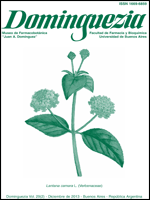Artículos similares
- Elizabeth A. Barrientos, Mabel S. Feijóo, Roxana B. Peneff, Evangelina Laztra, Adriana C. Gratti, Estudios anatómicos y análisis fitoquímicos preliminares de Monocotiledóneas hidrófitas en "mallines" de la estepa Patagónica , Dominguezia: Vol. 30 Núm. 2 (2014)
- Alejandro Fabián Vugin, Graciela Beatriz Bassols, Beatriz Graciela Varela, Alteraciones anatómicas en epidermis de hojas infectadas de Phoradendron bathyoryctum Eichler (Viscaceae) , Dominguezia: Vol. 31 Núm. 2 (2015)
- Raquel Romeo, Plantas empleadas en medicina popular en la provincia de Jujuy. Departamento Capital y alrededores. , Dominguezia: Vol. 31 Núm. 2 (2015)
- Adriana Gratti, Mabel S. Feijóo, Elizabeth A. Barrientos, Roxana B. Peneff, Evangelina Laztra, Caracteres anatómicos, morfofuncionales y químicos de Senecio subpanduratus (Asteraceae) , Dominguezia: Vol. 30 Núm. 1 (2014)
- Beatriz G. Varela, Teresa Fernández, Carlos Taira, Paula C. Zelozzi, Rafael A. Ricco, Eloisi Caldas López, Élida Ãlvarez, Alberto A. Gurni, Silvia Hajos, Marcelo L. Wagner, El "muérdago criollo", Ligaria cuneifolia (R. et P.) Tiegh -Loranthaceae-. Desde el uso popular hacia el estudio de los eféctos farmacológicos , Dominguezia: Vol. 17 Núm. 1 (2001)
- María Victoria Coll Aráoz, Graciela I. Ponessa, Anatomía foliar y caulinar de Lippia turbinata f. magnifolia Moldenke -Verbenaceae- (Loc. Vipos, Dpto. Trancas, Tucumán, República Argentina) , Dominguezia: Vol. 23 Núm. 1 (2007)
- Marta N. Colares, Marcelo P. Hernández, María C. Novoa, Vanesa G. Perrotta, Silvana Auguet, Ana M. Arambarri, Anatomía comparada de raíces medicinales de hierbas terrestres rioplatenses (Buenos Aires, República Argentina) , Dominguezia: Vol. 30 Núm. 1 (2014)
- Isabel Basualdo, Nélida Soria, Plantas medicinales comercializadas en el mercado municipal de la ciudad de Pilar, Dpto. Ñeembucu, Paraguay , Dominguezia: Vol. 30 Núm. 2 (2014)
- Andrea Alejandra Medina, Antonela Pampiglioni, Evelyn Riquelme, Características y contenido de extractivos del leño de Discaria chacaye y Ochetophila trinervis (Rhamnaceae) de zonas de ecotono del suroeste de la provincia de Neuquén , Dominguezia: Vol. 36 Núm. 2 (2020)
- Carlos Gustavo Altamirano, Marta Esther Yajía, Análisis comparativo de las estructuras endomorfológicas de hojas verdes sin procesar y zapecadas de Ilex paraguariensis A. St. Hil. (Aquifoliaceae). Modificaciones cito-histológicas. , Dominguezia: Vol. 34 Núm. 1 (2018)
1-10 de 72
Siguiente
También puede Iniciar una búsqueda de similitud avanzada para este artículo.
Artículos más leídos del mismo autor/a
- María L. Martínez, Gabriel Bettucci, Martha Gattuso, Adriana Cortadi, Caracteres micrográficos analíticos de hojas, tallos, inflorescencias-flores de Tagetes lucida Cav. (Asteraceae - Helenieae) , Dominguezia: Vol. 29 Núm. 1 (2013)
- Martín I. Rodríguez Morcelle, Ana Lía Rossi, Martha Gattuso, Nancy M. Apóstolo, Composición de los aceites esenciales de especies de Verbena nativas de la provincia de Buenos Aires bajo cultivo , Dominguezia: Vol. 31 Núm. 2 (2015)
- Martha Gattuso, Micrografía analítica y la farmacobotánica , Dominguezia: Vol. 29 Núm. 1 (2013)
- Martha Gattuso, Las plantas medicinales en Latinoamérica , Dominguezia: Vol. 29 Núm. 2 (2013)
- María N. Campagna, Osvaldo Di Sapio, Martha Gattuso, Parámetros micrográficos para la identificación de hojas, corteza y leño de Picrasma crenata (Vell.) Engl. (Simaroubaceae) , Dominguezia: Vol. 29 Núm. 1 (2013)


